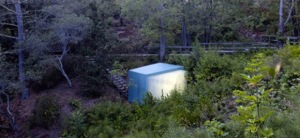
Sol Grotto, © Ronald Rael and Virginia San Fratello
“The canopy of a tree, say a poplar, like a round house, removed the site of vulnerability—the obvious entrance and back with no protections. Privacy can creep about in the leaves and below them, hang here as lungs on the outside.”—Hazel White, “Peril as Architectural Enrichment”
As I clutched my guide map for the recent exhibit, Natural Discourse: Artists, Architects, Scientists and Poets in the Garden at the UC Botanical Gardens, I was reminded of the connection between discourse and learning, between walking and contemplation. In fact, the Latin root for “discourse” is discurrere, meaning “to run about.” This is precisely what co-curators Mary Anne Friel and Shirley Watts have encouraged visitors to do, albeit at a turtle’s pace. Strolling through the Botanical Gardens in Berkeley from end to end, we view works of art displayed among the rare plant species. Friel and Watts have created intriguing points of interest to guide our way through the time-based experience of the exhibition’s making. Much like the follies of English landscape and picturesque design, the artifacts of the exhibition pull the viewer this way and that across the park, to ponder different points of view, both intellectual and geographic.
Landscape architecture is rich with explorations of the intersection between walking and contemplation, between artifact and learning. Aristotle is said to have started the Peripatetic School, which advocated the importance of walking and learning, instructing students along a path that encircled the Lyceum of the Acropolis. The very word, “peripatetic” is simultaneously a transliteration of the ancient Greek word, peripatetikos, which means, “of walking” or “given to walking about” and the Peripatos, the colonnade in which they met to start their studies. The architectural structure of their meeting and the act of walking were conjoined.
Artist and co-curator Mary Anne Friel’s Water Pavilion creates such a place of contemplation. The sign directs us to clamber up the steep path toward two pre-existing water tanks in UCBG’s Mediterranean Area. The space between them has been joined by an implied third: two semi-circular walls built of salvaged tank staves form an enclosure open to the sky. Rewarded by a free falling trail of water on the far end, the sounds of the fountain sooth and divert our attention. However, as we turn around, the vista of the Golden Gate Bridge is revealed beyond, this quintessential Bay Area view framed between the slot through which we entered. Standing within the centered form of Friel’s architectural moment, our view radiates out, reaching into the landscape and beyond. The work connects us visually to our place within the larger context of the city, following the tradition of 19th century follies, often poised to extol the virtues of a particular vista.
In contrast, Sol Grotto, by architects Ronald Rael and Virginia San Fratello, creates an architectural space that brings the surrounding landscape in rather than connecting out. This time, we descend a set of stairs to the perfectly crafted box that is the work. Poised on an existing viewing platform along Strawberry Creek, the structure is painted a soft mist green on the outside, rendering it almost invisible within the thick foliage of the stream bank. Inside, all four walls have been painted black, but the one facing the stream has been penetrated by 1400 glass tubes. The tubes amplify and focus the light, the sound and the air of the creek, drawing it into the space where we comfortably sit. Cool breezes from the stream are diverted via the Ventura effect. The ends of the tubes glow with an iridescent ring of light that subtly changes as clouds pass by. Protruding at different distances, the glass tubes create an undulated wall of shimmering light, echoing the natural landscape beyond. Put an eye up to a single tube, and the landscape outside is isolated to a single pixel. The glass tubes were recovered from Solyndra, the controversial recipient of Recovery Funding from the Obama administration. Solyndra had hoped to create advanced solar panels from racks of such tubes. The tubes were designed for an enhanced ability to capture light, here giving the interior of Sol Grotto an ethereal and magical quality.
Poets Denise Newman and Hazel White are interested in the stories implicit in the plants themselves. Working closely with UCBG horticulturists, Newman and White have reinterpreted the standard botanical labels into abstract poems. The elegance of Botanical Recognita: Signage to Facilitate a Greeting is the utilization of the vocabulary inherent to the scientific nature of the garden without calling attention to the piece as art object in the traditional sense. The line has been blurred. This leads the viewer to question and become curious about both.
The Forest Monks of Northeast Thailand put a great emphasis on walking meditation as the preferred method to deepen their practice and develop concentration. At the crest of the Doi Suthrep Mountain peak is the Theravada temple of the same name, Wat Phrathat Doi Suthrep, a inner structure covered in gold leaf, the outer structure decorated with a continuous eave of bells, which emanate a delightful and multilayered ringing into the surrounding landscape. The faithful walk through rice fields and up a series of two hundred steps to reach this sacred spot. On a recent visit, I walked through the bright green rice fields at the base of the mountain and balanced on top of the single-track path separating the water soaked lands of one field from the next. My native guide laughingly informed me that this was the Thai treatment for the spiritual duress. I thought he had a point. There was something pleasantly soothing about concentrating on the placement of my feet, one step in front of the other. The boundaries between self and other, art and science, between artifact and plant did seem to fade away and disappear.
